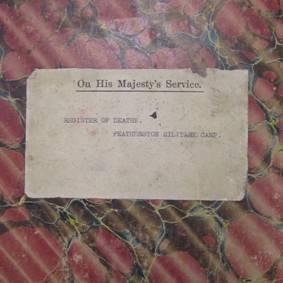Recently I discovered that an ominous sounding ‘death register’ could transport me back into the lives of men and women who died nearly 100 years ago.

Cover of Featherston Camp Death Register. Archives New Zealand.
My colleague Tim Shoebridge and I came across this death register while researching connections between the 1918 influenza pandemic and the First World War.
The register lists soldiers who died during their four months’ training at Featherston camp from January 1916 to November 1918, either at the camp itself or any other place. It also includes men who died earlier while the camp was being built, camp staff, and those who died there after the war. The camp was a military hospital and prisoner of war camp until December 1919.
I spent days poring over the pages of the register, which include details such as exact time and cause of death and whether next of kin were present. The contents caused me to reflect on just how difficult life must have been for the medical staff working at the camp during the 1918 influenza pandemic.
A page of the Featherston Camp death register. Held in Archives New Zealand, R23696006.
I plan to write a little about these challenges in the book Tim and I are working on. However, I probably won't include what I found next. It’s that little bit of extraneous detail that an editor will prune – but this is the part that really made me grieve for one of these individuals nearly 100 years after they had died.
I realised when analysing the dates of death that in two short days at the height of the camp’s epidemic its medical staff lost three colleagues. Nurse Sister Mabel Wishaw, who had worked at the camp for three years, chemist Quartermaster Sergeant Bert (Bertram) Boock, and doctor Captain Allan Leslie Christie. Boock and Christie had both served overseas in the war.
Notice of death for Bert Boock. Evening Post, 15 November 1918, page 4.
I imagined remaining staff managing an increased workload while no doubt concerned or grieving for their ill or dead colleagues.
When looking at Bertram Boock’s personnel file I learnt just what rotten luck he really had. Not only had he served overseas during the war and returned home safely only to die of disease – but he appeared to have died on his birthday. He was just 32, the same age as me.
If it wasn’t for Bertram’s birthday I would likely have left his story at that, but I couldn’t resist seeing what else was out there. Within a couple of seconds he was staring me in the face from this copy of a memorial booklet.
In loving memory. Bertrand's memorial booklet pinned above my desk.
The memorial poem reads:
In the blossom of his life death claimed him;
In the pride of his manhood days;
Noone knew him, but to love him;
Noone mentioned his name but with praise.
If I wasn’t grieving for Bertram and thinking of his family before, I was after that. I don’t think I’ll go another Armistice Day – the anniversary of the day after Bertram's death on 10 November 1918 – without thinking of this chemist and the tough situation faced by medical staff at Featherston Camp.
I love how the Featherston Camp death register can bring to life a situation and an individual nearly 100 years after his death. Until looking at this register, I’d only thought of the medical staff as busy and at greater risk. Bertram was just another name with a date of death and a serial number.
I hope others researching the First World War or undertaking genealogical research find the register, and all the other digital resources out there, just as enlightening.
Imelda is currently writing a book on New Zealand's First World War Heritage with Tim Shoebridge.